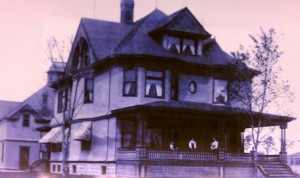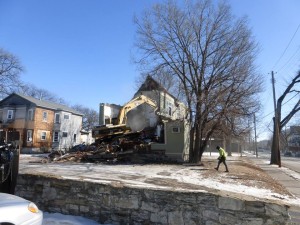
Welcome to the
Healy Project
Join us on Facebook
Send us an Email
Talk: Preservation Advocacy, August 17th

Supporters of the Healy Project gather in front of the Orth House for a photo to be posted on the National Trust’s page, “Places That Matter.”
The story of the fall of the Orth House will be told as part of a talk and exhibit on preservation advocacy sponsored by Preserve Minneapolis and the Preservation Alliance of Minnesota. Anders Christensen of the Healy Project will narrate the two-year- long fight to save the 1893 Healy-built house from demolition. The story of the Orth House, along with other stories of preservation advocacy, will be part of a talk and discussion at the Hennepin History Museum, 2303 Third Ave. South. Thursday, August 17th, 6:30-9:30 p.m. The museum is hosting an exhibit of these stories beginning August 10th.
If you can’t make it to the talk or exhibit, you can read about the fight for the Orth House, its demolition and the aftermath on posts on this blog. It’s a story that’s painful for those of us who fought to save it. . . .and a story that members of the City Council, City Planning, and local developers would like to forget. But it should and must be told.
The deck is almost always stacked against old historic buildings when developers take their promises of higher density and higher tax base to City government. The big triumph over the small, the new over the old, the affluent over those of modest means. The Healy Project will keep fighting as long as old buildings are threatened. And they will always be threatened.
T.B.
Last Friday Minneapolis Mayor Betsy Hodges went on her political Facebook page to take Nicole Curtis to task for her criticism of City Council members. Curtis, the “Rehab Addict” had criticized City officials on her Facebook page for their failure to answer to the corrupted process that led to the demolition of the Orth House on February 25th. Since then, an all-out slugfest has ensued on social media, distracting people from the issue of the lying that went on in public hearings and in District Court about the condition of the Orth House. (See previous posts on this blog.)
Let’s turn our attention away from the demolished Orth House. Let’s cut through the smokescreen issuing from City Hall and focus upon the corrupted process of testimony that brought down the house. Mayor Hodges and CM Bender need to stop pitying themselves and do some explaining about the lack of integrity in the process of testimony before the City Council. Their attack on Curtis, a resident of CM Bender’s ward, is nothing short of self-serving meanness.
Curtis is not just a media star; she is a Minneapolis taxpayer. City officials going after a constituent-critic on social media is unethical, to say the least. Hodges and Bender have gone so far as to kick constituent-critics off their Facebook pages. Democracy in action? If city officials attacked a developer the way they are attacking their own constituents, they’d be slapped with a lawsuit so fast their heads would spin. Apparently, they think it’s OK for those in power to go after private citizens. There oughta be a law. Well, in fact, there is. It’s called the City’s Code of Ethics.
If the goal of these elected officials is to silence their critics, they are not doing a very good job of it. People don’t like feeling shut out of expressing their views to those who represent them. People like even less being fed a load of blather generated from lies as answer to their concerns. 
For the record:
1. The owner of the Orth House filed an appeal to demolish an historic resource. Hodges voted to make it an historic resource in 2013. It became no less historic after CM Bender took office.
To reiterate from a previous post: “At the appeal hearing chaired by CM Bender, both Michael Crow (owner) and John Smoley (Planning staffer) were allowed presentations in favor of demolition. The HPC’s position was reported but not presented; reporting is not a substitute for a persuasive presentation earnestly defending the HPC’s position. It seems appropriate that some provision be made in cases which staff’s professional opinion differs from the decision-making making body.
Something is amiss when the recommendations of both presentations are in agreement with one another. By definition, an appeal is a scenario where one opinion is not in agreement with another.”
In their own defense, City officials trot out the judge’s findings on the Healy Project’s MERA lawsuit to stop the demolition of an historic resource. These findings, like the City Council’s 11-2 vote to demolish the Orth House, were based on false testimony. The lies continue.
2. Mayor Hodges cites a post from a local blogger to document the vulgar comments being made about CM Bender. It turns out that these comments were cut out of threads of many hundreds of comments on Curtis’s “Rehab Addict” Facebook page. Citing this blogger as a credible source of information is like citing Glenn Beck as proof that Obama wasn’t born in the US.
The Twitter feed from this blogger is a nonstop tirade of name-calling against CM Bender’s detractors, including members of the Healy Project. Last year, the blogger doxed Curtis, a single mother. This is as low as you can go. Doxing is a tactic used to threaten and silence women (primarily), so the Twitterer pretending he’s protecting CM Bender from gendered attacks is total hogwash.
The Healy Project conceded that the house’s demolition was a determined matter. We hoped that the process issues could be examined separately from one’s feelings or opinions about the house. CM Bender’s response via posting on Facebook a decision based on the corrupted testimony is a distraction from our inquiry for examination of protocol and process. It’s time for City officials to stop grandstanding and start talking to Minneapolis citizens.
Elected City officials should not be fueling vitriol against their own constituents. If they’re so thin-skinned, they should consider new career paths. Let’s take the “discussion,”if it can be dignified with the term, off Facebook and Twitter and turn to addressing the issue of corrupted testimony. To refuse to do so undermines the public trust.
Until city officials get serious about examining this process, Mayor Hodges, CM Bender, and other officials will have no credibility with many of their constituents.
Their attack on Nicole Curtis has become a national story. Their foolish social media campaign against her has made Minneapolis into a laughingstock.
In January of last year: A political dogfight breaks out in New Jersey after one of the governor’s aides initiated “traffic problems” on a commuter bridge. The issue behind the controversy was lucrative development contracts (what else?). An all-out battle ensued involving the governors of NY, NJ, the Port Authority, and mayors in NJ cities. It was brutal. However, not once did any of them complain that their feelings had been hurt by their political opponents.
No problem was ever solved when those in power refused to sit down and talk. Come on, Mayor Hodges and CM Bender. Get off the low road of social media and get down to fixing problems and moving ahead.
T.B.
Developers repeatedly trot out claims based on the tenets of New Urbanism: affordability, diversity, easy access, and sustainability. For example, as seen in the previous post, the Lander Group’s promotion of its 2320 Colfax project as “affordable” is not credible, given the rents required for units in new Wedge buildings. However, the Lander Group’s bogus claim of affordability is not the most egregious subversion of New Urbanist principles. A much more serious misrepresentation resides in the statement that this building will consist of “‘Eco-Flats – promoting ‘Green-Living’. . .close to and providing a variety of transportation options, services, recreation, and green space.”
What does this mean? Not that the building is green, but that the living in it will be green. How will this be green? By the developer putting in fewer parking spaces than will be needed for 45 units, providing an HourCar, a “variety of bike storage options”, and a bike-repair stand. First of all, the assumption that the majority of tenants won’t own cars is ridiculous. That’s an ideal of New Urbanist planning that is far from being realized. 80% of American adults own at least one car. If the project has the Wedge average of 1 1/2 tenants per unit, the complex could be short of parking by 34 spaces. Many workplaces are simply not accessible by public transportation, and many people who bike to work often suspend bike commuting during the winter. Second, the amenities available nearby (bus routes, bike paths, HourCar, parks, nearby shops and restaurants) are already there, and will be there, Lander project or not.
Using the prefix “Eco-” as a descriptor is a marketing ploy to suggest that this project will be good for the environment–which it most decidedly will not be. Wrecking the houses at 2320 and 2316 will cost the developer about $60k–to be added to construction costs–and would involve removing 250+ tons of building materials, excluding the foundations, to the landfill. Historic preservation is environmental preservation. According to the World Bank, “sustainable development recognizes that growth must be both inclusive and environmentally sound to reduce poverty and build shared prosperity for today’s population and to continue to meet the needs of future generations. It must be efficient with resources and carefully planned to deliver both immediate and long-term benefits for people, planet, and prosperity.”[1] The proposed Lander development at 2320 Colfax is decidedly inefficient in its use of resources. Ironically using the rhetoric of ‘green living,’ the developer seeks to destroy the Orth House and replace it with new construction–the least environmentally responsible option available.
Article after article about conservation reiterates the point that “green building” is an oxymoron. You can’t have both. As Jerri Holan, a Fulbright scholar and member of the AIA, points out: “The facts are in – no matter how much green technology is employed, any new building represents a new impact on the environment.It makes no sense for us to recycle newspapers, bottles, and cans while we’re throwing away entire buildings and neighborhoods.It’s fiscally irresponsible and entirely unsustainable.” [2]
The Minneapolis Heritage Preservation and City Council have determined the Orth House to be an “historic resource.” Razing historic buildings results in a triple hit on scarce resources. First, we are throwing away thousands of dollars of embodied energy. The greenest thing we can do is to continue the life of a building whose resources have already been extracted from our planet. Using data from the Advisory Council on Historic Preservation, we can calculate that the Orth House, at 6,400 square feet, embodies roughly 9.6 billion BTUS of energy, equal to 77,000 gallons of gasoline. If that building is torn down, all that embodied energy is wasted. What’s more, the demolition process itself consumes energy.[3]
The Lander website claims that their project would use “better construction techniques.” Hmm–better construction than what? Certainly not better than the house currently standing at 2320, which was built by T.P.Healy in 1893 of lumber from Minnesota’s virgin forests. The historic Orth House would be replaced with materials vastly more consumptive of energy. What is the Orth House built from? Timber, plaster, limestone, and bricks. These are the least energy consumptive of materials. The major components of new buildings, by contrast, are the most energy consumptive–plastic, steel, vinyl and aluminum.
An important part of New Urbanist strategy is the preservation of existing buildings and historic architecture. The reasons for this are twofold: historic preservation not only saves “places that matter” for future generations, but conserves rapidly dwindling natural resources and energy sources. The fact that the Lander project is a larger building than the Orth House does not offset the energy consumed in destroying the old one and building the new. Even if this building were LEEDS (Leadership in Energy and Environmental Design)-certified[4] and built on an empty lot (which it is not), it would take many decades to offset the loss of resources. “By 2030, we will have demolished and replaced nearly 1/3 of our current building stock, creating enough debris to fill 2,500 NFL stadiums. How much energy does this represent? [E]nough to power California (the 10th largest economy in the world) for 10 years. By contrast, if we rehabilitate just 10% of these buildings, we could power New York for over a year.”[5]
New building can never be greener than existing structures, yet Minneapolis keeps saying it espouses sustainability while demolishing dozens of buildings annually. At the root of the problem is the functional life of new buildings. Contemporary buildings are considered to be disposable even as they go up. Take, for example, the Metrodome and the 1981 Walker Community Library building. These structures stood on sites cleared of older buildings for their construction. Only three decades years later, they both were demolished, sending thousands of tons of building materials to landfills. Meanwhile, across the street from the third Walker library, the first 1911 Classical Revival library building still stands, adaptively reused as commercial space.
New Urbanism is a comprehensive philosophy of urban planning. But so far, Minneapolis has been dealing with demolition on a case-by-case basis. An owner wants to wreck an historic resource: staff representing City Planning say, sure, wreck away. . .There are better examples of Healy’s work. This process of finding better examples of this and that can go on until there is literally one Healy house left standing. Lander’s development could have a suitable place in Minneapolis, but not on the site of the Orth House. If 2320-2316 were vacant lots, the Lander project would have already been built. Minneapolis should not be curating a museum, but maintaining community character and identity.
Minneapolis must develop a policy dealing with demolitions that takes into account both historical and ecological resources. Marketing buzz words should not be a substitute for responsible urban stewardship.
“Our duty is to preserve what the past has had to say for itself, and to say for ourselves what shall be true for the future.”–John Ruskin
–T.B
C.A.C.
In promoting their new projects, developers repeatedly trot out claims based on the tenets of New Urbanism: affordability, diversity, easy access, and sustainability.
“New Urbanism promotes the creation and restoration of diverse, walkable, compact, vibrant, mixed-use communities composed of the same components as conventional development, but assembled in a more integrated fashion, in the form of complete communities. These contain housing, work places, shops, entertainment, schools, parks, and civic facilities essential to the daily lives of the residents, all within easy walking distance of each other.”–NewUrbanism.org

Want to live in hip, starry-neon-skied Lime in the Wedge Greenway, where (as their sign proclaims) “tarts” are welcome? Prepare to shell out big bucks for a small space.
Let’s look at the claims of the Lander Group for its proposal at 2316-2320 Colfax Avenue South and see how they square with the aims noted above. Lander wants to wreck the Orth House at 2320 to clear the site for a 45-unit apartment building. The Lander website says that the 2320 project is “geared to more affordable budgets with the smaller sizing, and real transportation options.” To be cost-effective for the developer, the rents in new units need to be set at least at market rate. Currently, rents for 500-square-foot studios in new Wedge buildings start at $1200 per month. This is not “affordable” housing by any stretch of the imagination. Even if Lander/At Home do as stated keep the rent under $1,000 to start with (still above average for the area), there’s nothing to stop them from raising it afterward. This is exactly what happened at the joint Lander-Gerberding apartment project at 46th and 46th. They were initially advertised as market rate [1], but now are luxury [2]. If the developer is serious about affordability, let him sign a contract with the City for a fixed-rent range.
The fact is that the older rental units are the affordable ones. New apartment construction, to be cost effective for the developer, must have rents set higher than for existing structures. The result is what we now have in the Wedge Greenway: 1800+ units built or under construction that are inhabited largely by young, affluent white people. The aim of the marketing campaigns for these Greenway apartments is to attract young suburbanites to the city for a few years before they settle down in neighborhoods of mostly single-family homes: “Don’t get hitched until you enjoy your year at Lime”, “I don’t remember her name, but her apartment” (Elan). This kind of marketing and pricing does not produce a racially, socially or economically diverse community, but an enclave of privileged “urban tourists,” slumming in the Wedge for a few years. So much for developers adhering to the “diversity” and “affordable” parts of New Urbanist planning.
The Lander website touts “real transportation options” (as opposed to imagined options?) available to future tenants. “The building concept promotes ‘green’ living – close to and providing a variety of transportation options, services, recreation, and green space.” Lander’s “concept” has not produced these amenities, which are available to anyone living in the area. Bus lines run on Hennepin, Lyndale, and Franklin right now.The Wedge has always been a very walkable part of the city, close to lakes, parks, and shopping. Minneapolis is currently the most bike-friendly city in the country. Hour Cars are available now at Franklin and Dupont, a short walk away; bike racks can be built into any structure.

In addition, the developer and development supporters totally ignore New Urbanism’s mandate to conserve resources: to lift people out of poverty, to use energy wisely, and to build community. An important part of this mandate is to preserve the cultural resources and history of the community–an aspect developers conveniently forget, and in fact, as is obvious in the case of 2320 Colfax, scorn.
“Regional architectural styles, historic preservation and shared public space are also crucial.”—Charter for the New Urbanism
This is what the idealized sketch of the proposed Lander building looks like:

Architectural drawings are often out of context, a building surrounded by sky and trees (and sometimes a flock of birds). This building could go just about anywhere, a ho-hum block of flats that is hyped as “affordable” and “sustainable”–but isn’t. (See post on “Greenwashing Demolition). Imagine instead an adaptive reuse of the Orth House, designed to fit in with new residential construction on the site, a multiple-unit complex that would not require sending 250+ tons of building materials to the landfill.

“Cities grow, evolve and combining the new with the old in the same area will acknowledge the history of the place. Projects that pay homage to the existing fabric of a space, but also incorporate new architecture would be my ideal.”–Martina Ernst, Wo-Built Inc. – Innovative Design and Build, Toronto
The Lander proposal is designed with one primary goal: to maximize profits for the developer, with no regard for the neighbors or neighborhood. Let’s not forget that the Lander project did not win approval by the LHENA neighborhood board.
Lander, the property owner, and their for-hire expert contend that the Orth House does not have structural integrity. But don’t just take the word of people who will make hundreds of thousands of dollars from its demolition. John Jepsen of Jepsen Structural Services, a company specializing in structural shoring, lifting and straightening, has examined 2320 Colfax. Last year he testified before the City Council that the house is structurally sound, “built of old growth timber, straight and true.”
The owner and the broker who engineered the deal with Lander also contend that it would economically unfeasible to rehab the house. Again, are we to simply take the word of those who will reap substantial financial gain from its demolition? Those who have been inside the house, like myself, have found that many of the original features remain on the first floor and on the exterior.The upper floors were redone after a fire, but this provides interesting options for redesign.
A redevelopment that would include the Orth House would be the green, sustainable, affordable option, a reuse that would be sensitive to community concerns, city history, and fit in with existing buildings in the North Wedge.
Reuse. Reinvest. Retrofit. Respect.
–T.B.
“Merlin, if you don’t stop whining, I’m going to take Gwen’s sword and beat you to death with it,” said Arthur, evenly.
“It’s plastic.”
“So it will take me a long time. I’m still game.”
― FayJay, The Student Prince
 |
| The Orth House later this year? |
 |
| The Orth family on the porch of their house (2320 Colfax S.), 1890s. |

| 1936 photo of Second Ave S. from the 31st Steet intersection |
 |
| The Hudson House in the days before people sitting on the porch didn’t see a freeway across the street. |
 |
| Do not pave up to historic houses. |
Answer: The one standing.
So says Carl Elephante, Director of Sustainable Design at Quinn Evans Architects. Last year, the National Trust for Historic Preservation released a study, “The Greenest Building: Quantifying the Environmental Value of Building Reuse,” with data that supports this contention. The report uses Life Cycle Analysis (LCA) to compare the relative impacts of building renovation and reuse versus new construction. The description of the study says that it “examines indicators within four environmental impact categories, including climate change, human health, ecosystem quality, and resource depletion.”
 |
| copyright, National Trust for Historic Preservation |
According to the study, wrecking a building and replacing it with a new one comes with very high environmental and economic costs. Let’s look at what how these costs apply to the wrecking of the historic Orth House at 2320 Colfax Ave. S.in order to build the Lander Group’s new four-story apartment building:
First is the cost of destroying the existing structure. Wrecking the Orth House (and its neighbor at 2316) will cost the developer approximately $30,000 each. Add to this cost, the waste of the building materials of the house. The Orth House, a large 6,000+-square-foot house, is estimated to weigh 180 tons, not including the foundation (John Jepsen, Jepsen, Inc.). The Orth House was built in 1893 of lumber from Minnesota’s virgin forests. This irreplaceable resource will be hauled off to a landfill, never to be used again. The plaster, lath, windows, and mechanical systems will similarly be trashed. Yes, some of these features could be removed for salvage; however, the sad fact is that staircases, doors, and windows in a house of this size and vintage cannot easily be fitted into an existing structure. To reuse them, one would have to custom build a structure they could fit into. And what’s the point of that when they are already serving their purpose in the existing house?
 |
| The Orth House today. |
Second is the cost in labor and materials to build the new structure. New construction consumes many resources. The developer’s claim about energy savings makes no sense because new construction consumes so much energy upfront in producing new materials. (U.S.Green Building Council) The proposed apartment building is not one that uses a variety of “green” features and technologies, but a run-of-the mill structure. Recycling bins and bicycle racks do not a green building make. In fact, according to the Trust’s study, when replacing an average existing building with a new, more efficient building, it still requires as many as 80 years to overcome the impact of the construction.
 |
| The Orth House c. 1900 |

Recycling existing buildings is essential to creating sustainable cities.
Minneapolis, do the right thing: Support sustainability and save the historic Orth House from the landfill.
–T.B.



















